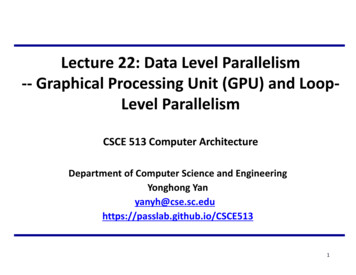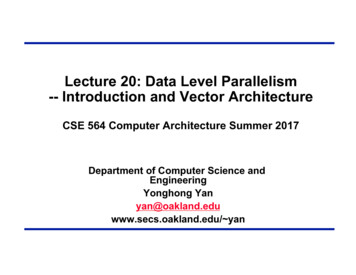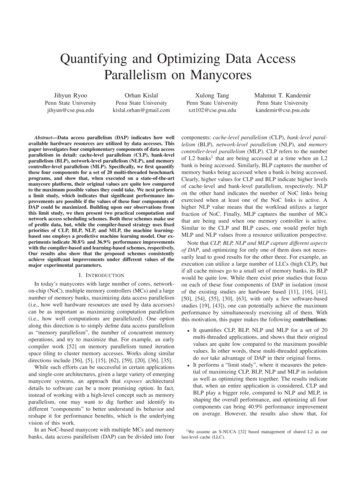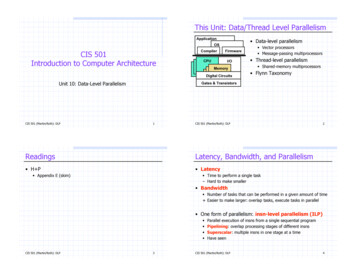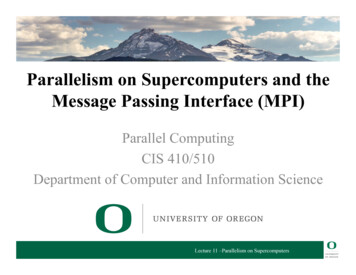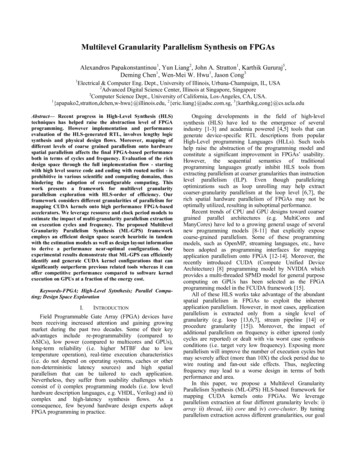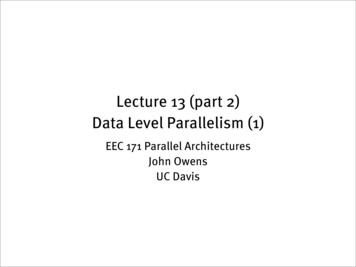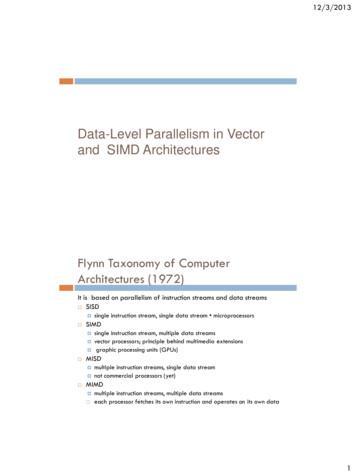
Transcription
12/3/2013Data-Level Parallelism in Vectorand SIMD ArchitecturesFlynn Taxonomy of ComputerArchitectures (1972)It is based on parallelism of instruction streams and data streams SISD single instruction stream, multiple data streamsvector processors; principle behind multimedia extensionsgraphic processing units (GPUs)MISD single instruction stream, single data stream microprocessorsSIMDmultiple instruction streams, single data streamnot commercial processors (yet)MIMD multiple instruction streams, multiple data streamseach processor fetches its own instruction and operates on its own data1
12/3/2013SISD architecture Le SISD architectures sono quelle classiche nellequali non è previsto nessun grado di parallelismo nétra le istruzioni né tra i dati.MISD architecture MISD è una architettura abbastanza inusuale nellaquale più istruzioni concorrenti operano sullo stessoflusso di dati.Un campo di applicazione possono ad esempioessere i sistemi ridondanti, come i sistemi di controllodegli aeroplani nei quali se uno dei processori siguasta l'elaborazione dei dati deve continuareugualmente.2
12/3/2013SIMD architecture This form of parallel processing has existed since the 1960sThe idea is rather than executing array operations by loop,we execute all of the array operations in parallel ondifferent processing elements (ALUs) we convert for(i 0;i n;i ) a[i] ; into a single operation, sayA A 1Not only do we get a speedup from the parallelism, we alsoget to remove the looping operation (incrementing i, thecomparison and conditional branch)These technologies are often applied in the field of audio /video codecs and video games. For example, if a polygon is moved, it is necessary to translate all itsvertices by adding to each of them the same value.MIMD Solitamente nella categoria MIMD si fanno rientrarei sistemi distribuiti, nei quali più processori autonomioperano in parallelo su dati differenti.3
12/3/2013SIMD vs MIMD SIMD architectures can exploit significant data-levelparallelism for:matrix-oriented scientific computing media-oriented image and sound processors SIMD is more energy efficient than MIMD Only needs to fetch one instruction per data operationMakes SIMD attractive for personal mobile devicesSIMD allows programmer to continue to thinksequentiallySIMD parallelism Vector architecturesMultimedia SIMD instruction set extensionsGraphics Processor Units (GPUs)4
12/3/2013Potential speedup via parallelism over time forx86 computers. For x86 processors: Expecttwo additionalcores per chip per year SIMD width to doubleevery four years Potential speedup fromSIMD to be twice thatfrom MIMD!Vector Architectures Basic idea: Readsets of data elements into “vector registers” Operate on those registers Disperse the results back into memory Registers are controlled by compiler Usedto hide memory latency Leverage memory bandwidth5
12/3/2013Vector Architectures provide high-level operations that work on vectors (linear arrays ofnumbers) e.g. add two 64-element vectors in 1 step, instead of using a loopreduce IF, ID bandwidthinstruction represent many operationsreduce HW complexity to support ILP the computation on each element does not depend on the otherscheck hazards once for vector operandsince a loop is replaced by an instruction, loop branch, control hazardsdisappearimprove memory access deeply-pipelined vector load/store unit a single access is initiated for theentire vector (bandwidth of one word per clock cycle after initial latency)VMIPS Example architecture: VMIPS Loosely based on Cray-1Vector registers Vector functional units Fully pipelinedData and control hazards are detectedVector load-store unit Each register holds a 64-element, 64 bits/element vectorRegister file has 16 read ports and 8 write portsFully pipelinedOne word per clock cycle after initial latencyScalar registers 32 general-purpose registers32 floating-point registers6
12/3/2013Structure of VMIPS Vector ProcessorThe VMIPS processor has a scalararchitecture just like MIPS.There are also eight 64-elementvector registers, and all thefunctional units are vectorfunctional units.The figure shows vector units for logicaland integer operations so thatVMIPS looks like a classic vector processor(Cray 1). The vector and scalar registershave a significant number of readand write ports to allow multiplesimultaneous vector operations.Crossbar switches (thick graylines) connects these ports tothe inputs and outputs of thevector functional units.VMIPS Instruction Set Aside from the ordinary MIPS instructions (scalaroperations), we enhance MIPS with the following: LV,SV – load vector, store vector LVV1, R1 – load vector register V1 with the data starting at thememory location stored in R1 also LVI/SVI for using indexed addressing mode, and LVWS andSVWS for using scaled addressing modeV1, V2, V3 (V1 V2 V3) ADDVS.D V1, V2, F0 (scalar addition) ADDVV.D similarlyfor SUB, MUL and DIV7
12/3/2013VMIPS Instruction Set S--VV.DV1, V2 and S--VS.D V1, F0 to comparepairwise elements in V1 and V2 or V1 and F0 --is one of EQ, NE, GT, LT, GE, LE result of comparison is a set of boolean values placed intothe bit vector register VM which we can then use toimplement if statements POPR1, VM – count number of 1s in the VM and storein R1 thisis only a partial list of instructions, and only the FPoperations, see figure 4.3 for more detail, missing are anyinteger based operationsVMPIS instruction Set8
12/3/2013VMPIS instruction SetExample Let’s look at a typical vector processing problem, computing Y a*X Y Where X & Y are vectors and a is a scalar (e.g., y[i] y[i] a*x[i])The MIPS code is on the left and the VMIPS code is on the rightL.DF0, aDADDI R4, Rx, #512Loop: L.DF2, 0(Rx)MUL.D F2, F2, F0L.DF4, 0(Ry)ADD.D F4, F4, F2S.DF4, 0(Ry)DADDI Rx, Rx, #8DADDI Ry, Ry, #8DSUB R20, R4, RxBNEZ R20, LoopL.DLVMULVS.DLVADDVV.DSVF0, aV1, RxV2, V1, F0V3, RyV4, V2, V3V4, RyIn MIPS, we execute 578 instructionswhereas in VMIPS, only 6 (there are 64elements in the array to process, each is 8bytes long) and there are no RAW hazards orcontrol hazards to deal with9
12/3/2013VMIPS Instructions ADDVV.D: add two vectorsADDVS.D: add vector to a scalarLV/SV: vector load and vector store from address Example: DAXPY L.DLVMULVS.DLVADDVVSV F0,aV1,RxV2,V1,F0V3,RyV4,V2,V3Ry,V4; load scalar a; load vector X; vector-scalar multiply; load vector Y; add; store the resultRequires 6 instructions vs. 578 for MIPSVector Execution Time Execution time depends on three factors: Lengthof operand vectors Structural hazards Data dependencies VMIPS functional units consume one element perclock cycle Executiontime is approximately the vector length10
12/3/2013Convoy A convoy is a set of sequential vector operationsthat can be issued together without a structuralhazard Becausewe are operating on vectors in a pipeline, theexecution of these operations can be overlapped e.g.,L.V V1, Rx followed by ADDVV.D V3, V1, V2 wouldallow us to retrieve the first element of V1 and then start theaddition while retrieving the second element of V1Chimes A chime is the amount of time it takes to execute aconvoy Wewill assume that there are no stalls in executing theconvoy, so the chime will take n x – 1 cycles where x is thelength of the convoy and n is the number of data in thevector A program of m convoys will take m chimes, or m * (n x –1) cycles (again, assuming no stalls) The chime time ignores pipeline overhead, and so architectsprefer to dicuss performance in chimes11
3SVV1,RxV2,V1,F0V3,RyV4,V2,V3Ry,V4;load vector X;vector-scalar multiply;load vector Y;add two vectors;store the sumMULVS.DADDVV.D3 chimes, 2 FP ops per result, cycles per FLOP 1.5For 64 element vectors, requires 64 x 3 192 clock cyclesVector Chaining Vector version of register bypassingWithout chaining, must wait for last element of resultto be written before starting dependent instructionWith chaining, can start dependent instruction as soonas first result appears12
12/3/2013Challenges Start up timeLatency of vector functional unit Assume the same as Cray-1 Floating-point add 6 clock cyclesFloating-point multiply 7 clock cyclesFloating-point divide 20 clock cyclesVector load 12 clock cyclesChallenges Improvements: 1 element per clock cycle Non-64 wide vectors IF statements in vector code Memory system optimizations to support vector processors Multiple dimensional matrices Sparse matrices Programming a vector computer 13
12/3/2013Multiple Lanes Element n of vector register A is “hardwired” to element n ofvector register B Allows for multiple hardware lanesMultiple Lanes Each line contains a portion of vector register file and one executionpipeline from each vector functional unit14
12/3/2013Vector Length Register Vector length not known at compile time?for ( i 0; i n; i )Y[i] Y[i] a*X[i]; n is know at run timeUse Vector Length Register (VLR) VLR cannot be greater than the size of the vector registers, themaximum vector lenght (MVL)MVL determines the number of data in a vectorVector Length Register Use strip mining for vectors over the maximum length:low 0;VL (n % MVL); /*find odd-size piece using modulo op % */for (j 0; j (n/MVL); j j 1) { /*outer loop*/for (i low; i (low VL); i i 1) /*runs for length VL*/Y[i] a * X[i] Y[i] ; /*main operation*/low low VL; /*start of next vector*/VL MVL; /*reset the length to maximum vector length*/}15
12/3/2013Vector Mask Registers Consider:for (i 0; i 64; i i 1)if (X[i] ! 0)X[i] X[i] – Y[i];This loop cannot be normally vectorizedIteration can be vectorized for items for which X[i] ! 0Use vector mask register (VM) to “disable” elements: SNEVS.DV1,F0This instruction sets VM(i) to 1 if V1(i)! F0When VM register is enabled, vector instructions operate only on theelements with VM(i) equal to oneClearing VM, vector instructions operate on all elementsVector Mask RegistersLVV1,Rx;load vector X into V1LVV2,Ry;load vector YL.DF0,#0;load FP zero into F0SNEVS.DV1,F0;sets VM(i) to 1 if V1(i)! F0SUBVV.DV1,V1,V2 ;subtract under vector maskSVRx,V1;store the result in XGFLOPS rate decreases!16
12/3/2013Memory Banks Memory system must be designed to support high bandwidthfor vector loads and storesSpread accesses across multiple banks Control bank addresses independently Load or store non sequential words Support multiple vector processors sharing the same memoryExample: 32 processors, each generating 4 loads and 2 stores/cycle Processor cycle time is 2.167 ns, SRAM cycle time is 15 ns How many memory banks needed?Stride Consider:for (j 0; , 64; j j 1)A[i][j] B[k][j] * D[j][m];}row[i]LVLVWSMULTWSW V1, RBV2, (RD,R2)V3,V1,V2RA, V3column[m]row[k]; RB contains address of row B[k]; RD contains address of D[0][m] and R2 contains row size; RA contains address of row B[k]Must vectorize multiplication of rows of B with columns of DUse non-unit strideBank conflict (stall) occurs when the same bank is hit faster than bank busy time: #banks / LCM(stride,#banks) bank busy time17
12/3/2013Scatter-Gather Consider:for (i 0; i n; i i 1)A[K[i]] A[K[i]] C[M[i]];Use index vector:LVVk, RkLVIVa, (Ra Vk)LVVm, RmLVIVc, (Rc Vm)ADDVV.DVa, Va, VcSVI(Ra Vk), Va;load K;load A[K[]];load M;load C[M[]];add them;store A[K[]]Programming Vec. Architectures Compilers can provide feedback to programmers Programmers can provide hints to compiler18
12/3/2013SIMD Extensions Media applications operate on data types narrower than thenative word size Example: disconnect carry chains to “partition” adderLimitations, compared to vector instructions: Numberof data operands encoded into op code No sophisticated addressing modes (strided, scattergather) No mask registersEsempi di estensioni di tipo SIMD Le più diffuse sono: Apple/IBM/FreescaleAltiVec Intel MMX/SSE/SSE2/SSE3/SSSE3 AMD 3DNow! SPARC VIS ARM Neon/VFP MIPS MDMX/MIPS-3D19
12/3/2013SIMD Implementations Implementations: Intel MMX (1996) Streaming SIMD Extensions (SSE) (1999) Eight 16-bit integer opsFour 32-bit integer/fp ops or two 64-bit integer/fp opsAdvanced Vector Extensions (2010) Eight 8-bit integer ops or four 16-bit integer opsFour 64-bit integer/fp opsOperands must be consecutive and aligned memorylocations20
SIMD architectures can exploit significant data-level parallelism for: matrix-oriented scientific computing media-oriented image and sound processors SIMD is more energy efficient than MIMD Only needs to fetch one instruction per data operation Makes SIMD attractive for personal mobile devices
